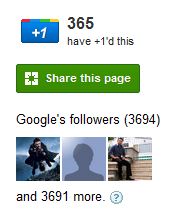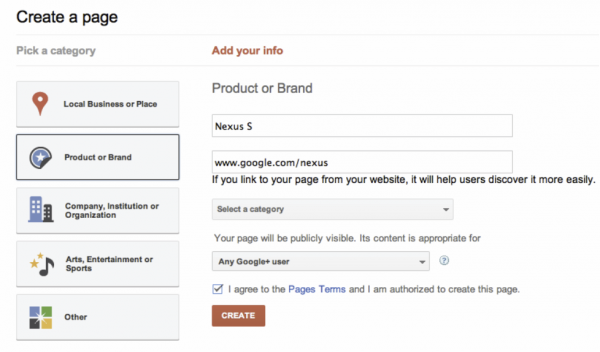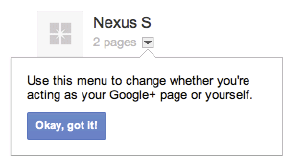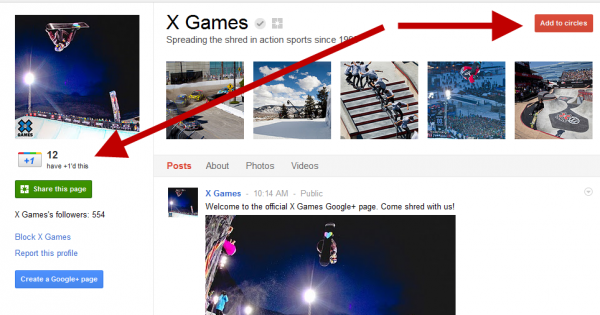Google+ Pages Now Open For Businesses, Brands, Places & More
Finally, Google is now allowing businesses, brands and any non-human entity to participate in its Google+ social network, through new Google+ Pages that are launching today, promised to be available to everyone shortly. Businesses Weren’t Allowed, Initially Businesses have wanted to be part of Google+ from the start. In fact, many businesses and brands made […]
 Finally, Google is now allowing businesses, brands and any non-human entity to participate in its Google+ social network, through new Google+ Pages that are launching today, promised to be available to everyone shortly.
Finally, Google is now allowing businesses, brands and any non-human entity to participate in its Google+ social network, through new Google+ Pages that are launching today, promised to be available to everyone shortly.
Businesses Weren’t Allowed, Initially
Businesses have wanted to be part of Google+ from the start. In fact, many businesses and brands made use of regular Google+ accounts as a way to participate on the service despite their non-human status.
However, in July, Google terminated any business accounts that it spotted, including one from Sesame Street, promising that formal business pages would come — and that they’d be worth waiting for.
Google+ Pages Now Welcome Businesses
Now businesses are being welcomed in, through the new Google+ Pages program. Beginning today, and rolling out over the next two days, businesses will be able to create Google+ pages for themselves, using the Create A Page tool (and assuming you already have a regular Google+ account — more on this below).
Not everyone who goes to that page will get in (many will get a “Google+ Pages isn’t ready for everyone” message). Again, it’s a random rollout happening over the next two days (NOTE: Google tells us now everyone should have access). But once you gain access, you’ll be asked to create a page in one of five categories:
- Local Business or Place
- Product or Brand
- Company, Institution or Organization
- Arts, Entertainment or Sports
- Other
Local Is Different
If you’re creating a page for a local business, you have special options including the ability to enter a phone number. From Google’s help page on the topic:
Local Google+ pages are unique from other categories of pages because they have features that allow customers to easily connect with that business’s physical location. For example, local pages include a map of the business’s location and feature its address, phone number, and hours of operation.
Of course, many local businesses have already claimed their pages in the completely separate Google Places. Much of the information that Google+ Pages for local businesses wants — and more — are on those pages. But they remain unconnected. Google tells me:
Currently, Place pages and Google+ Pages must be managed separately. A Place page provides information about a business and makes it easy for customers to find local businesses on Google Maps and local search; while a Google+ page provides business owners with additional ways to engage, build relationships and interact directly with customers.
Creating A Google+ Page
Here’s a look at the initial page creation form, which asks for basic information such as a brand name and a URL:
At first, whoever creates the page initially will also be the page administrator. No one else will be able to admin that page after them, at first. Nor can that page be transferred to someone else.
Multiple administrator support is promised in the near future, but until it arrives, it seems important that if your company has a social media manager, that person should be the one to create the account.
Unlike Facebook, there aren’t “vanity” URLs yet available that use a business name rather than a long string of number. The same issue is true of personal accounts. Google provided no update on when this might change.
Don’t like the name of your page? Unlike with Facebook, you can change that at any time. However, if you have verified status, doing this will cause you to lose verification, requiring that process to start again, Google told me.
“Acting” Like A Page
Similar to Facebook, even though you’ll access your page through a personal account, you’ll have the ability to choose whether you want to act as yourself or the business page, when on Google Plus.
You can do many of the same things that a personal account can do, including:
- Share photos
- Share videos
- Share links
- Conduct Hangouts
It doesn’t appear that there’s any support for automatically posting to a page, in the way people can using both native and third-party tools with Twitter and Facebook. That’s likely to come as part of a future Google+ API release. Google gave no further update on when this is coming.
Pages can follow people, but not until they’ve been first followed. That’s nice. It’s not unusual to see business accounts on Twitter follow a bunch of people, just in hopes of getting a reciprocal follow-back. Google+ won’t reward such behavior.
Some other minor differences between business pages and personal pages are also listed here. My favorite? “Pages can’t play games.”
Multiple Pages OK
Another difference from personal accounts is that it’s perfectly fine for a business to have multiple Google+ pages. From the help page:
Pages can be made for a variety of different entities whereas profiles can only be made for people.
If you’re a business, you could have a page for the overall business (say Pepsi) as well as for a particular product (say Diet Pepsi) as well as for an event (say the Dew Tour). And, I’d say you should do this, just as many people find this useful at Facebook, if you have good reasons for each entity to have its own dedicated page.
Being Circled As A Business
Google has Google +1 buttons all over the web, but clicking on one of these buttons on a web site doesn’t cause a business to be followed within Google Plus. Instead, as with regular accounts, business pages have to be added to a Google+ circle.
It’s kind of confusing. Consider this business page for the X Games:
See the two big arrows. The one pointing to the right is for a new +1 button count (more below) that people can push. But pushing that won’t follow the page. Instead, people have to push the “Add To Circles” button to follow the page (and that doesn’t automatically like or +1 the page).
+1 Counts
Having said this, business pages will have something unique compared to regular pages — an overall Google +1 count that shows on their profile page, as you can see in the screenshot below:

See how there’s a “542,625 Have +1’ed this” section? This is supposed to show all the +1s that a site has earned on all their pages in total. After the regular circle counts are also shown.
However, seeing this live, it appears instead that the +1 count is really just the number of people who have +1’d the particular business page, not all the +1’s on pages within the entire site. Otherwise, the number for Google’s own site should be a lot higher than the 300s.
Postscript: Google tells me that in the next few weeks, the +1 count will change to show all +1s to a particular site. For the moment, it only shows +1s to a page.
Badges & Verification
To encourage brands to get followed, Google is launching a new icon to let business pages encourage being followed, with badges — including one similar to Facebook’s “Facepile” badge, promised to be coming soon:
There’s a new badge maker page that’s up, though so far, it’s only offering an icon for using in linking your site to a Google+ page, as explained more below.
Some big or well-known brands will also have Verified Name options, similar to how these work for people.
Direct Connect: Being Found In Search
Another new feature for businesses is the ability to have their pages found through “Direct Connect” in Google Search. This will happen for any business that Google determines is particularly relevant for a search, if it is linked (see below) and if someone searches for the business with a + symbol in front of its name:
If people select the Google+ Page, they’ll be taken directly to that Google+ Page, where they can then follow, if they want.
Google’s done a short video explaining how this works (my testing for pages like +Pepsi or +Google, where it’s supposed to work, don’t show that it has kicked in yet):
[youtube width=”560″ height=”315″]https://www.youtube.com/watch?v=NY8L_SzNr70[/youtube]
Making this feature possible is why Google somewhat controversially removed how the + command worked last month. But a Google spokesperson told me:
Even before Google+, we’d seen on one hand extremely limited usage of the plus operator, a fraction of a percent of all queries. And of that, the majoirty were using the plus operator incorrectly.
After Google+ itself launched, Google said even more people started using the + operator, but in the wrong way. So dropping it probably did make sense — though Google shouldn’t have done it so quietly, and without a blog post explaining the move, I’d say.
What If Someone Else Makes “Your” Page?
Anyone can make a business page for any URL without providing proof that they somehow “own” or are associated with that URL. Potentially, that means pages can pretend to be representing a site they’re not connected with.
Verification for big brands (see below) is one way Google aims to combat any problems this might cause. Google also told me that until a Google+ page is connected to a web site (see below), pages also cannot put icons or badges up, nor will they have a chance at being shown in a Direct Connect display.
We’ll see how it goes. Verification has helped people better locate “real” people within Google+ already. But there are still plenty of confusing fakes around
Linking Pages To Sites
I’d mentioned earlier how a site could be linked to a Google+ page. In particular, there’s an entire Google help pages here and here about this. Linking enables the chance of Direct Connect. It requires:
- Rel=”publisher” link for your site to your Google+ page
- Link from your page back to home page or main page of the site
Google also recommends the use of a the new icon it is offering, which you can find on the badge maker page.
Businesses Already With Pages
As said, the new system is rolling out over the next two days. A small number of businesses were allowed to create pages early, which include:
Interestingly, Ford — which is one of the few businesses that were allowed to have “Test” business accounts — is not in the initial release of the new business pages. Google confirmed this to me and added that all these accounts would have to build followers from scratch, just like anyone else.
Postscript: Search Engine Land now has its own page on Google Plus — you’ll find us here.
More Information
Google has a short video up about the new pages:
[youtube width=”560″ height=”315″]https://www.youtube.com/watch?v=8Ccf5GxM7vg[/youtube]
There’s also a blog post here, as well as help pages here.
Postscript: See our follow-up stories:
- Up Close With Creating & Managing Google+ Pages
- Google+ Pages For Businesses: The AdWords Impact
- A Look At Google+ Direct Connect For Google+ Pages
You can also now add Search Engine Land to your Google+ circles and keep up with us on the service.
Contributing authors are invited to create content for Search Engine Land and are chosen for their expertise and contribution to the search community. Our contributors work under the oversight of the editorial staff and contributions are checked for quality and relevance to our readers. The opinions they express are their own.
Related stories
New on Search Engine Land





